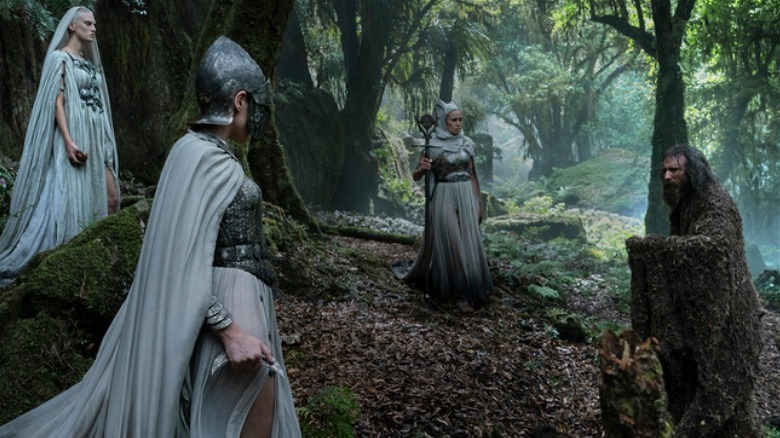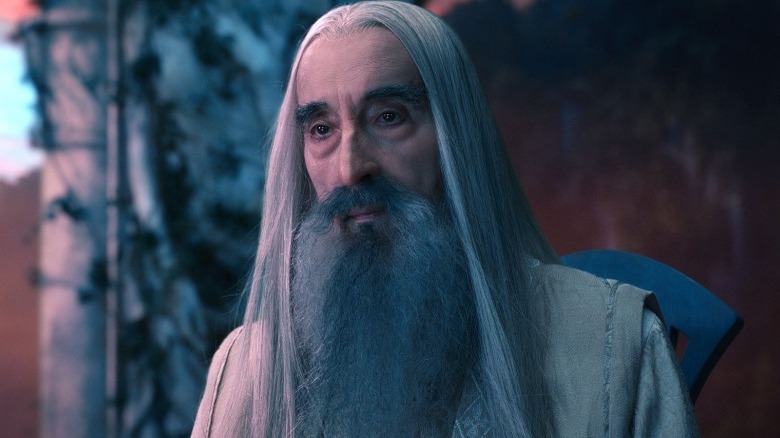
This post contains spoilers for "The Lord of the Rings: The Rings of Power."
Prime Video's "The Rings of Power" concluded its first season with a heart-thumping finale, while managing to bring stray narrative threads together in a satisfying fashion. A lot of big reveals took place, confirming flaming hot fan theories: Halbrand is Sauron! The Stranger is Gandalf! ... and so on. Apart from this, we saw the forging of the Elven rings of power, Galadriel being faced with irresistible temptation, and Sauron straight up walking into Mordor. While the "Rings of Power" finale is a feast, I would like to talk about the implications of an important location mentioned in the episode: Rhûn, or the Eastlands.
The episode opens with a fake-out when the Cult of Melkor approaches The Stranger (Daniel Weyman) and hails him as Sauron. The group tells him that a veil prevents him from understanding who he truly is, which explains his loss of memory and moral tussle. When The Stranger discloses the constellation that is supposed to be his destination, the cult reveals that he is meant to travel to Rhûn and establish his dominion there by gathering followers. As the cult is mistaken about The Stranger's identity — he is the other, Istar, or the Wise — we need to understand the significance of Rhûn and the role it is about to play in shaping the history of Middle-earth.
Rhûn Has A Complicated History

Most inhabitants of Middle-earth know little about Rhûn, or the Eastlands, a region that lies in the east, bordered by the great sea of Rhûn. Per J.R.R. Tolkien's work, the first Elves and Men awoke in the far east in the era, along with the first Dwarves. While some chose to migrate to the West over the years, some chose to stay behind, which created divergent cultures and ways of life. Most of the men who remained in Rhûn came to serve Morgoth when he was powerful, and these devoted servants, later known as the Easterlings, attacked Gondor and its allies several times during the Third Age.
Keeping this bit of history in mind, it makes sense for the Cult of Melkor to guide who they believe to be Sauron to Rhûn, and they wish to set the Dark Lord on the path to uniting the East against the West. Ironically, this does turn out to be the case, as Sauron manages to unite the Easterlings under his banner during the Second and Third ages.
Moreover, within the context of Tolkien's lore, the West is believed to be untouched by evil, while the East is commonly associated with the shadow of Mordor. Thus, the show's decision to send Gandalf to Rhûn is interesting, as Tolkien's saga dictates that no one apart from Aragorn had set foot in the Eastlands. Could Gandalf's presence in Rhûn help fill in the gaps between the events of the show and the War of the Ring?
The Presence Of The Istari In Rhûn

Although "The Rings of Power" does not explicitly spell out that The Stranger is Gandalf, we can make an educated guess that such is the case. First, he is repeatedly established as a force of good who is important to the course of Middle-earth history, and the word "wizard" is mentioned when explaining the meaning of Istar. There's also the "when in doubt, always follow your nose" line spoken by him, which is an endearing reference to what he said to Merry in "The Fellowship of the Ring."
As Gandalf does not fully understand who he is or what role he is meant to play, he and Nori (Markella Kavenagh) must travel to Rhûn for answers. The rest of the Istari, or Wise ones, which include the Blue Wizards and Saruman, are known to have traveled to the East sometime during the Second and Third Ages. As Sauron was able to hide in the East and gather his followers during the Watchful Peace, the Blue Wizards are said to have failed in their mission to detect evil in the East. As the two were never seen again, they might have either perished or succumbed to evil.
Could it be possible that Gandalf will cross paths with his kind in Rhûn? Although it is unclear as to when exactly Saruman might have traveled to the East, it is possible that he helps Gandalf find his purpose in the East. Although we know about Saruman's eventual fall from grace, he was wise and discerning once and held in great esteem by Gandalf and the others.
Some Interesting Tidbits About Rhûn

-
Sauron went to Rhûn to hide from the White Council throughout the Watchful Peace that lasted for four centuries. He rallied the Easterlings under his cause and used them to wage war against Gondor.
-
The Dwarves of Rhûn had taken the initiative to travel from Rhûn to join other dwarf clans in the War of the Dwarves and Orcs in the Misty Mountains. When Sauron's power was at its peak, there was considerable unrest in Rhûn, which prompted countless dwarves to seek refuge in the Western lands.
-
Gondor held control of parts of Rhûn on two occasions under Romendacil I and II. Eventually, the area was subjugated during Aragorn's rule during the Fourth Age, and Gondor entered into a peace accord with the Easterlings.
-
Apart from the Easterlings and some Dwarven clans, Rhûn was also home to men who had fallen to darkness, along with the Avari and the Umanyar, who were Elves known to have rejected the summon of the Valar.
Read this next: The Best Easter Eggs In The Lord Of The Rings: The Rings Of Power Episodes 1 And 2
The post What are The Lands of Rhûn? The Lord of the Rings' Eastlands Explained appeared first on /Film.
0 Comments